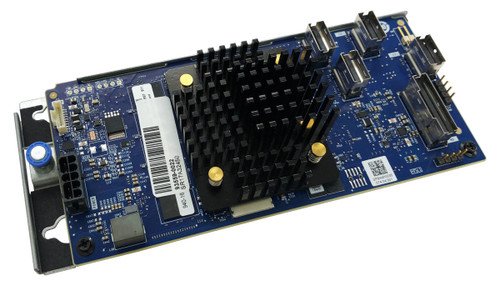In the world of IT hardware, where data is the lifeblood of modern business, ensuring its safety, speed, and accessibility is paramount. While processors and RAM often steal the spotlight, a critical component works tirelessly behind the scenes to manage and protect your most valuable asset: your stored data. This component is the RAID Controller Card. For anyone building a robust server, a high-performance workstation, or simply looking to understand the backbone of reliable data storage, grasping the function and importance of this piece of computer hardware is essential. But what exactly is it, how does it work, and why should you consider one over software-based alternatives? This comprehensive guide will demystify the RAID Controller Card and explore its vital role in your system.
What is a RAID Controller Card?
At its core, a RAID Controller Card is a specialized piece of computer hardware—typically a printed circuit board that fits into a PCIe (Peripheral Component Interconnect Express) slot on your motherboard. Its primary function is to manage multiple hard disk drives (HDDs) or solid-state drives (SSDs) in a Redundant Array of Independent Disks (RAID) configuration. Think of it as a dedicated traffic cop for your data storage. Instead of your computer’s main CPU having to manage the complex tasks of reading from and writing to multiple drives simultaneously, it offloads this responsibility to the dedicated processor on the RAID Controller Card. This specialized hardware is designed specifically for the input/output (I/O) operations required by RAID setups, leading to significantly improved performance and reliability.
How a RAID Controller Card Works
The operation of a RAID Controller Card is a marvel of specialized IT hardware engineering. When your system requests data, the process unfolds as follows:
-
Data Interception: The card intercepts the data requests from the operating system before they reach the physical drives.
-
Processing & Distribution: Its onboard processor, often with its own dedicated memory (cache), calculates how to distribute the data across the drives based on the configured RAID level. For example, in a RAID 5 setup, it calculates the parity information; in a RAID 1 setup, it duplicates the data to a second drive.
-
Execution: The card then executes the necessary read/write commands to the individual drives in the array.
This entire process happens transparently and at incredible speeds, freeing up the main system CPU for other tasks and ensuring optimal storage performance.
RAID Controller Card vs. Software RAID: A Clear Winner?
Most modern operating systems, like Windows, Linux, and macOS, offer a feature called “software RAID.” This method uses the host system’s CPU and drivers to manage the RAID array. While it’s a cost-effective solution, it pales in comparison to using a dedicated RAID Controller Card.
The Advantages of a Hardware RAID Controller Card:
-
Superior Performance: This is the most significant advantage. By offloading all RAID calculations to its dedicated processor, a hardware RAID Controller Card eliminates the CPU overhead associated with software RAID. This results in faster data transfer rates and lower latency, which is crucial for database servers, virtualization hosts, and high-traffic file servers.
-
Enhanced Reliability & Features: Hardware cards offer advanced features not found in software solutions. These include a dedicated cache (with battery backup to protect data in transit during a power failure), support for booting from the RAID array, and more robust failure management like hot-swap capabilities and detailed monitoring.
-
OS Independence: Since the RAID Controller Card handles the RAID configuration at the hardware level, the array is presented to the OS as a single disk. This makes the array portable between different systems or operating systems, as long as the same card or compatible IT hardware is used.
-
Broader RAID Level Support: Hardware controllers typically support a wider range of complex RAID levels (like 5, 6, 50, 60) efficiently, which are often too CPU-intensive for software implementations.
When Software RAID Might Suffice:
Software RAID is a viable option for simple setups, such as a home media server using RAID 1 for basic mirroring, where budget is a primary constraint and performance is not critical. However, for any professional or business-critical environment, the investment in a dedicated RAID Controller Card is non-negotiable.
Key Features to Consider When Choosing a Card
Not all RAID Controller Cards are created equal. Selecting the right one depends on your specific needs and existing computer hardware. Here are the key factors to evaluate:
-
RAID Levels Supported: Ensure the card supports the RAID level you need (e.g., 0, 1, 5, 6, 10, 50, 60). Basic cards may only support 0, 1, and 10, while more advanced ones will include parity-based levels like 5 and 6.
-
Interface and Bus Speed: Most modern cards use PCIe slots. Pay attention to the PCIe generation (e.g., PCIe 3.0, 4.0) and the number of lanes (e.g., x8, x16), as this determines the card’s total bandwidth.
-
Drive Connectivity: Cards come with different ports:
-
SATA: Common but generally for lower-end cards.
-
SAS (Serial Attached SCSI): The professional standard. SAS controllers can also connect to SATA drives, offering greater flexibility and performance, making them a superior choice for serious IT hardware setups.
-
-
Onboard Cache: The amount of cache (RAM) on the card significantly impacts write performance. Look for cards with 1GB, 2GB, or more. Crucially, check if it has a Battery Backup Unit (BBU) or Super Capacitor to protect the cached data in case of a power outage.
-
Form Factor: Ensure the card physically fits your chassis. Standard form factors include Full-Height, Half-Length (FHHL) and Low-Profile (LP).
HBA vs. RAID Controller: Understanding the Difference
It’s crucial to distinguish a RAID Controller Card from a Host Bus Adapter (HBA). While they may look similar, their functions are distinct. An HBA is a simpler piece of computer hardware that essentially adds more ports to your system to connect drives. It does not manage a RAID array; it presents all connected drives individually to the operating system. Software RAID can then be used top of an HBA.
Common Applications for a RAID Controller Card
The RAID Controller Card is a cornerstone of professional IT hardware across numerous applications:
-
File and Application Servers: Where data availability and read/write performance are critical for multiple users.
-
Database Servers: These require extremely fast I/O operations and high data integrity, both delivered by a high-end RAID Controller Card.
-
Video Editing and Media Workstations: Handling large, high-bitrate video files demands the fast, sequential read/write speeds of a RAID 0 or RAID 5 array managed by a powerful card.
-
Virtualization Hosts: Hypervisors like VMware ESXi or Proxmox benefit immensely from the reliable and high-performance storage provided by a hardware
Conclusion:
In the intricate ecosystem of computer hardware, the RAID Controller Card stands out as a pivotal component for anyone serious about data management. It transcends the limitations of software-based solutions, delivering unparalleled performance, robust data protection, and enterprise-grade features that safeguard your digital technology. By investing in a quality RAID Controller Card, you are not just adding a piece of IT hardware to your server or workstation; you are investing in the very foundation of your data’s reliability, speed, and security. Whether you are an IT manager building a new server infrastructure or a creative professional building a powerful editing rig, understanding and utilizing a RAID Controller Card is a critical step toward achieving a truly resilient and high-performance storage system.




Leave a Reply